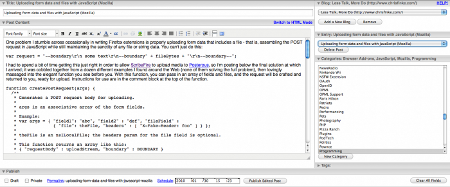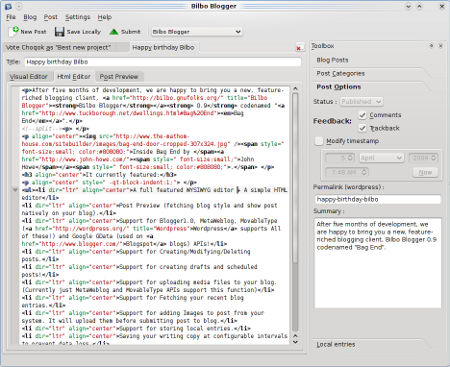A volte è utile lavorare non in linea, e una volta che l’articolo è terminato pubblicarlo sul vostro blog.
Sì, è possibile farlo con un editor html, o anche con un semplice editor di testo come Vi o Emacs, ma ci sono programmi specializzati che possono facilitare il vostro lavoro di pubblicazione e gestione del vostro blog online.
Quindi daremo uno sguardo a Scribefire, blogtk, Blogilo, Qumana e Drivel

Scribefire in editing mode
ScribeFire è un’estensione del browser (disponibile per Firefox, Chrome e Opera), di recente è stato distribuita la nuova versione: ScribeFire-next.
ScribeFire è un completo editor di blog che si integra con il browser e ti consente di scrivere articoli verso tutti i vostri blog.
Caratteristiche
Semplice interfaccia che si apre in una scheda in cui è possibile modificare visivamente, oppure è possibile utilizzare codice HTML o Markdown.
È possibile pubblicare articoli su i blog: WordPress, Blogger, TypePad, Windows Live Spaces, Tumblr, Posterous, Xanga, LiveJournal, o qualsiasi blog che supporti il MetaWeblog o MovableType API.
È possibile modificare e aggiornare i posti esistenti. È possibile pianificare gli articoli per il futuro (se il vostro blog lo permette). È possibile cancellare gli articoli. È possibile salvare le bozze. Potete usare e metetre negli articoli tag e categorie.
Un’altra caratteristica di ScribeFire è la possibilità di inviare lo stesso articolo su vari blog, dopo aver pubblicato il primo ti verrà data la scelta di pubblicarlo su uno o più dei tuoi altri blog.
Ok, questa non è una applicazione specifica per Linux, ma funziona bene e si può utilizzare su qualsiasi ambiente grafico senza alcun problema.
BloGTK
Come il nome lascia intuire, questo è un client blog specifico per l’ambiente GTK, quindi Gnome principalmente, ma può essere utilizzato su qualsiasi ambiente desktop.
BloGTK è scritto in Python e PyGTK,
Con BloGTK è possibile pubblicare i propri articoli su Blogger, WordPress, e qualsiasi blog compatibile con Movable Type. BloGTK rende facile la gestione degli articoli sul blog, soprattutto per le persone che hanno multipli blog.
In generale BloGTK funziona con qualsiasi sistema di blogging che supporti XML-RPC di pubblicazione.
Per scrivere un articolo e’ possibile selezionare la modalità WYSIWYG o HTML e si può avere un’anteprima del vostro lavoro.
Il grande problema che vedo in questo programma è che non è più aggiornato, l’ultima release è di gennaio 2009, dopo che ci sono solo alcune correzioni di bug minori, quindi mi viene da pensare ad esso o come un software maturo che ha terminato la sua vita, o forse, semplicemente non è più sviluppato attivamente.

Blogilo html Editor
Blogilo
Blogilo significa “Strumento per Blog” in Esperanto.
Blogilo è lo strumento sviluppato dalla community di KDE per scrivere e pubblicare post sui propri blog. Lo strumento è molto semplice, ed è in grado di gestire la maggior parte delle piattaforme di Blogging presenti in rete tra cui: Blogger1.0, MetaWeblog, MovableType (WordPress) e Google GData (usato su Blogspot.com) APIs!
La schermata principale permette la scrittura di un nuovo post, sul blog selezionato (grazie ad una comoda combobox presente nella toolbox in alto), è possibile utilizzare sia un editor WYSIWYG sia un editor HTML, inoltre vi è una comoda funzione di preview del post, che applica i CSS del proprio blog al post che si sta editando.
Sulla destra invece è presente un’altra toolbox che contiene l’elenco degli ultimi post del blog, le categorie ed i tag da associare al post in fase di editing e le opzioni di pubblicazione (bozza, pubblica, ecc).
Infine è possibile sia salvare una bozza in locale del post, sia procedere all’upload sul blog ed alla pubblicazione.
Come BloGTK questo software non viene aggiornato da qualche tempo, l’ultima release la 1.0.1 è uscita nel febbraio 2010.
Qumana
Qumana è una semplice applicazione per inserire post su più blog e piattaforme blog senza la necessità di loggarsi al servizio, è scritto in Java e quindi disponibile anche per altre piattaforme.
L’editor WYSIWYG consente di inserire testo ed immagini trascinando i file dal che abbiamo sul pc con un’operazione di copia e incolla. Qumana consente di inviare lo stesso post a più blog.

Le caratteristiche di Qumana includono una formattazione semplice, inserimento di testo e immagine, inserimento semplificato di tag Technorati, e l’inserimento di annunci pubblicitari.
Per gli annunci pubblicitari Qumana è affiliata con adgenta .
Caratteristiche
- Può essere utilizzato su Windows, Linux e Macintosh.
- Ricco editor WYSIWYG (What You See Is What You Get) con funzioni di base come grassetto, corsivo, sottolineato, allineamento del testo e delle immagini, elenco, blockquote, indentazione, collegamenti.
- Sottolinea parola che sono scritte male con il rosso
- Comprende un correttore ortografico. È possibile configurare il controllo ortografico per controllare l’ortografia del post durante la digitazione.
- Si possono Inserire gli annunci nel blog con un click.
- Consente di usare i Tag di Technorati
- E’ possibile Impostare il timestamp dei posti
- Consentire o meno i commenti
- Salva le voci come bozze e pubblicarli in una data futura
- Gli utenti possono modificare i post già pubblicati dalla Gestione Blog
- Si può Facilmente caricare immagini dal tuo computer
Conclusioni
Ad essere onesto non sono soddisfatto delle mie piccole ricerche in questa nicchia di programmi, un sacco di essi non sono più sviluppati e non ho visto le caratteristiche mozzafiato a cui sono abituato in altri tipi di programmi. Forse le interfacce web sono già troppo buone e quindi non c’è tanto impegno nel fare applicazioni desktop di questo tipo.
Personalmente, al momento, quella che preferisco è Scribefire è leggera, integrata con un browser e quindi facilmente utilizzabile su diverse piattaforme.
Popular Posts:
- None Found

I tried to use Blogilo for my Blogger-based blog. It did not work for me. 8-(
I think you meant Scribefire instead of Scribus on the last paragraph.
It was a great article though! thanks for writing about these nice tools! 🙂
Ops, you have reason 😉
Post fixed, thanks for the feedback.
Thats a nice list will give them a try, though I still prefer using the web interface directly and as you said the interfaces are good enough and do not drive people to develop programs for desktop I guess.